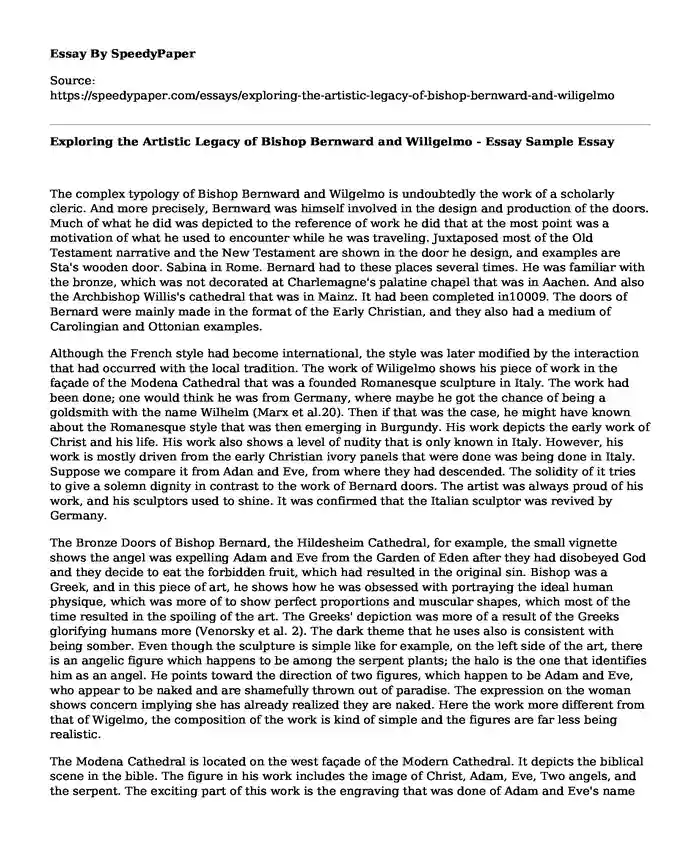
| Type of paper: | Essay |
| Categories: | Science Architecture |
| Pages: | 3 |
| Wordcount: | 727 words |
The complex typology of Bishop Bernward and Wilgelmo is undoubtedly the work of a scholarly cleric. And more precisely, Bernward was himself involved in the design and production of the doors. Much of what he did was depicted to the reference of work he did that at the most point was a motivation of what he used to encounter while he was traveling. Juxtaposed most of the Old Testament narrative and the New Testament are shown in the door he design, and examples are Sta's wooden door. Sabina in Rome. Bernard had to these places several times. He was familiar with the bronze, which was not decorated at Charlemagne's palatine chapel that was in Aachen. And also the Archbishop Willis's cathedral that was in Mainz. It had been completed in10009. The doors of Bernard were mainly made in the format of the Early Christian, and they also had a medium of Carolingian and Ottonian examples.
Although the French style had become international, the style was later modified by the interaction that had occurred with the local tradition. The work of Wiligelmo shows his piece of work in the façade of the Modena Cathedral that was a founded Romanesque sculpture in Italy. The work had been done; one would think he was from Germany, where maybe he got the chance of being a goldsmith with the name Wilhelm (Marx et al.20). Then if that was the case, he might have known about the Romanesque style that was then emerging in Burgundy. His work depicts the early work of Christ and his life. His work also shows a level of nudity that is only known in Italy. However, his work is mostly driven from the early Christian ivory panels that were done was being done in Italy. Suppose we compare it from Adan and Eve, from where they had descended. The solidity of it tries to give a solemn dignity in contrast to the work of Bernard doors. The artist was always proud of his work, and his sculptors used to shine. It was confirmed that the Italian sculptor was revived by Germany.
The Bronze Doors of Bishop Bernard, the Hildesheim Cathedral, for example, the small vignette shows the angel was expelling Adam and Eve from the Garden of Eden after they had disobeyed God and they decide to eat the forbidden fruit, which had resulted in the original sin. Bishop was a Greek, and in this piece of art, he shows how he was obsessed with portraying the ideal human physique, which was more of to show perfect proportions and muscular shapes, which most of the time resulted in the spoiling of the art. The Greeks' depiction was more of a result of the Greeks glorifying humans more (Venorsky et al. 2). The dark theme that he uses also is consistent with being somber. Even though the sculpture is simple like for example, on the left side of the art, there is an angelic figure which happens to be among the serpent plants; the halo is the one that identifies him as an angel. He points toward the direction of two figures, which happen to be Adam and Eve, who appear to be naked and are shamefully thrown out of paradise. The expression on the woman shows concern implying she has already realized they are naked. Here the work more different from that of Wigelmo, the composition of the work is kind of simple and the figures are far less being realistic.
The Modena Cathedral is located on the west façade of the Modern Cathedral. It depicts the biblical scene in the bible. The figure in his work includes the image of Christ, Adam, Eve, Two angels, and the serpent. The exciting part of this work is the engraving that was done of Adam and Eve's name in the background for identification. The sculpture was created by the use of the subtractive method. It is made of the Romanesque characteristic of Italian sculpture. There is no disproportionate body, and the figures are of similar size compared to the figure drawn by Bernward.
Works Cited
Marx, Nadia Lares. Images of Adam and Engagements with Antiquity in Romanesque and Gothic Sculpture. Harvard University, 2016.
Vendors, Sarah Jean. Visual Representations of Adam and Eve: An Iconographical Study of Medieval and Renaissance Images Concerning Genesis 1-3. Diss. Kent State University, 2016.
Cite this page
Exploring the Artistic Legacy of Bishop Bernward and Wiligelmo - Essay Sample. (2024, Jan 30). Retrieved from https://speedypaper.net/essays/exploring-the-artistic-legacy-of-bishop-bernward-and-wiligelmo
Request Removal
If you are the original author of this essay and no longer wish to have it published on the SpeedyPaper website, please click below to request its removal:
- Great Barrier Reef Facts - Free Essay in Chemistry
- Essay Example on the Travel Budget for the Trip to Micronesia
- Leo Tolstoy's Role as a Peacemaker - Free Essay Example
- Free Essay Example: Obesity Among the Children
- Paper Example on Technological Application in Bloodstain Pattern Interpretation
- Essay Sample on Body Dysmorphic Disorder (BDD)
- The Impact of Political Battles on Employee Morale and Decision-Making Processes - Essay Sample
Popular categories




